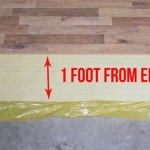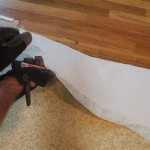If you’re looking to update the look of your home with a fresh and durable flooring option, vinyl flooring is a great choice. Vinyl flooring is easy to install and comes in a variety of colors, styles, and textures. Installing vinyl flooring can be a rewarding project that will give you an attractive and long-lasting floor in your home. Here is a comprehensive guide on how to lay down vinyl flooring.
Preparing The Room
Before beginning the installation of your vinyl flooring, it’s important to properly prepare the room. To begin, remove all furniture and items from the room, and make sure the subfloor is clean, dry, and free from debris. Fill in any cracks or holes in the subfloor with a wood filler or patching compound. Make sure to sand the area once it has dried.
Choosing The Right Materials
The next step is to choose the right materials for your vinyl flooring installation. Vinyl flooring comes in several different types, such as sheet vinyl, vinyl planks, and vinyl tiles. The type you choose will depend on your budget and the look you’re trying to achieve. You’ll also need to purchase an adhesive, underlayment, and transition pieces.
Installing The Underlayment
After you’ve gathered the necessary materials, you can begin installing the underlayment. The underlayment is a thin foam or rubber material that provides a cushion for your vinyl flooring. It also helps to reduce sound and provide a smooth surface for your flooring. Begin by cutting the underlayment to size, then roll it out with the smooth side facing up. Secure the edges with staples or adhesive.
Laying The Vinyl Flooring
Once the underlayment is installed, you can begin to lay the vinyl flooring. To make the process easier, it’s best to start at the wall furthest from the door. Begin by measuring the wall and cutting the vinyl flooring to size. Place the vinyl flooring on the underlayment and press it down firmly. Use a rolling pin to ensure a good bond between the vinyl and the underlayment.
Cutting The Vinyl Flooring
As you work, you may need to cut pieces of vinyl flooring to fit around doorways, corners, and other obstacles. To do this, use a sharp utility knife and a straight edge to score the vinyl. Then, apply pressure to the scored line until it breaks apart. You may also need to make small cuts for outlets and other fixtures.
Installing Transition Pieces and Finishing Touches
To finish the installation, install transition pieces around the perimeter of the room. These pieces help to bridge the gap between the vinyl flooring and other flooring surfaces, such as tile or carpet. Once the transition pieces have been installed, you can add any finishing touches, such as trim or baseboards. Finally, replace all furniture and enjoy your new vinyl flooring.




:max_bytes(150000):strip_icc()/easy-install-plank-vinyl-flooring-1822808-09-a1f83db7bdf74f279f45594b897de82d.jpg)




/cdn.vox-cdn.com/uploads/chorus_image/image/65891755/howto_vinylfloor_05.0.jpg)



:no_upscale()/cdn.vox-cdn.com/uploads/chorus_asset/file/19494137/howto_vinylfloor_08.jpg)

Related Posts








